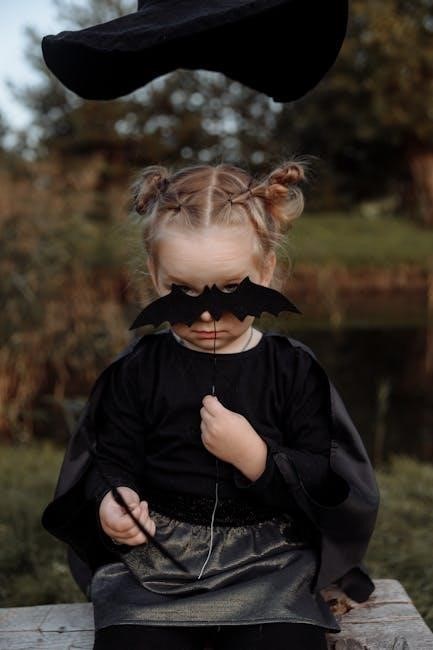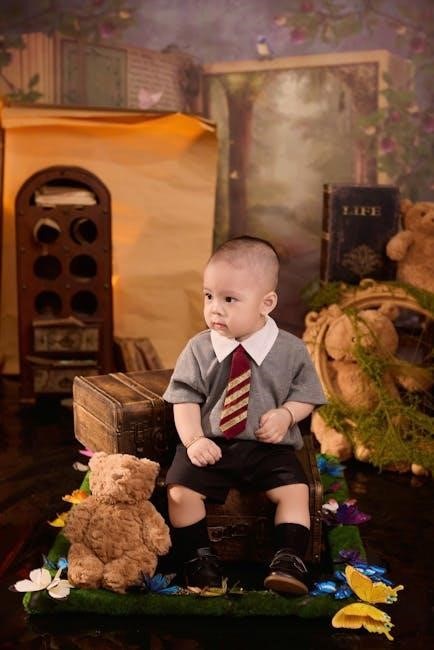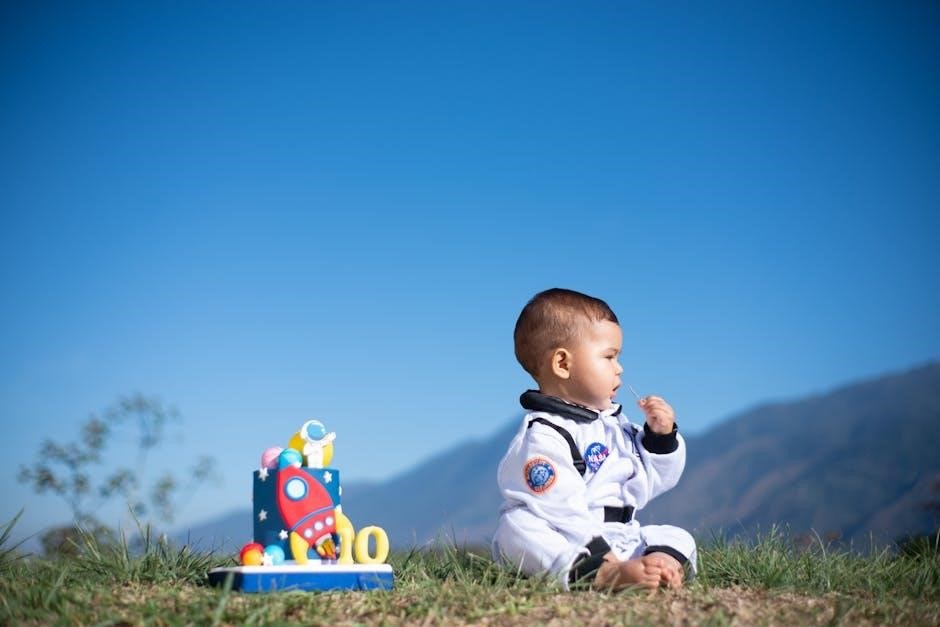
The Zoot Suit play, written by Luis Valdez, is a powerful musical drama that blends theater, music, and cultural activism, set against the backdrop of the 1940s Los Angeles riots and discrimination.
Historical Context of the Zoot Suit Play

The Zoot Suit play is set in 1940s Los Angeles, a time of heightened racial tensions and societal upheaval. The play draws heavily from real-life events, including the infamous Zoot Suit Riots of 1943, which erupted amid World War II. These riots were fueled by animosity between Mexican-American youths, who wore distinctive zoot suits as a symbol of cultural identity, and U.S. servicemen on leave. The play captures the discrimination and violence faced by the Mexican-American community, blending historical facts with dramatic storytelling. By revisiting this turbulent period, the play highlights the struggles of Chicano youth and their resistance to societal oppression, making it a powerful commentary on race, identity, and justice in America.
Significance of the Zoot Suit Play in Chicano Theater
Zoot Suit holds a landmark position in Chicano theater, marking a pivotal moment in the representation of Mexican-American experiences. Written by Luis Valdez, it was the first Chicano play to reach Broadway, breaking cultural barriers and challenging stereotypes. The play’s success not only elevated Chicano voices but also paved the way for future generations of Latinx playwrights and actors. Its blend of drama, music, and social commentary created a unique theatrical style that resonated with diverse audiences. By addressing themes of identity, discrimination, and resistance, Zoot Suit became a cultural touchstone, inspiring a movement toward greater inclusivity in American theater and solidifying its place as a cornerstone of Chicano literary and theatrical heritage.
Overview of the Play’s Structure and Style
Zoot Suit is a dynamic blend of drama, music, and cultural expression, set in 1940s Los Angeles. The play combines vivid storytelling with a mix of Spanish and English dialogue, reflecting the bilingual reality of its characters. Its structure is non-linear, weaving together courtroom drama, flashbacks, and symbolic sequences. The character of El Pachuco serves as a narrator and cultural icon, guiding the audience through the story. The play’s style is heavily influenced by Mexican-American culture, incorporating traditional music, dance, and slang. This fusion creates a vibrant and immersive experience, capturing the energy and resilience of the zoot suiters. The play’s innovative use of language and form makes it a groundbreaking work in American theater, blending social commentary with artistic innovation to tell a powerful story of identity and resistance.

Historical Background of the Zoot Suit Riots
The Zoot Suit Riots were a series of violent clashes in 1943 Los Angeles, fueled by racial tensions between Mexican-American youths and U.S. servicemen during World War II.
The Zoot Suit Riots of 1943: Causes and Consequences
The Zoot Suit Riots of 1943 were sparked by escalating racial tensions in Los Angeles, particularly between Mexican-American youths and U.S. servicemen on leave during World War II. The zoot suit, a flamboyant fashion statement, became a symbol of cultural pride for Mexican-Americans but was perceived as unpatriotic by servicemen. Media-fueled hysteria and economic competition exacerbated these tensions, leading to violent confrontations. Servicemen targeted zoot suiters, stripping them of their clothing, while local authorities often sided with the attackers. The riots highlighted deep-seated discrimination and resulted in widespread outrage within the Chicano community. They also had legal consequences, with many Mexican-Americans wrongfully accused and convicted. The events became a pivotal moment in Chicano history, inspiring resistance and activism, as depicted in Luis Valdez’s play Zoot Suit, which brought these injustices to the stage.
Racial Tensions in 1940s Los Angeles
Los Angeles in the 1940s was a city simmering with racial tensions, particularly against Mexican-Americans. The Zoot Suit phenomenon became a focal point for these tensions, as the stylish attire worn by young Mexican-American men was seen as a symbol of rebellion and defiance. The city’s growing Latino population faced discrimination in employment, housing, and education, fueling frustration. Additionally, the presence of U.S. servicemen on leave during World War II added to the volatile atmosphere, as they often viewed zoot suiters as unpatriotic. Media outlets further inflamed tensions by sensationalizing the zoot suit culture, labeling it as criminal. This environment of prejudice and hostility set the stage for the Zoot Suit Riots of 1943, which became a defining moment in the struggle for Chicano rights and identity.
The Role of Media in the Zoot Suit Riots
The media played a pivotal role in exacerbating the Zoot Suit Riots by sensationalizing the zoot suit culture and framing Mexican-American youths as criminals. Newspapers in Los Angeles published exaggerated stories, often depicting zoot suiters as lawless and unpatriotic, which fueled public outrage. Photographs of young men in their distinctive suits were splashed across front pages, further demonizing them. Radio broadcasts and editorials also contributed to the hysteria, painting the zoot suit as a symbol of delinquency rather than a fashion statement. This biased coverage not only justified the violence against Mexican-Americans but also ignored the underlying issues of racial discrimination and social inequality. The media’s role in shaping public perception highlights how misinformation and bias can escalate racial tensions and contribute to social unrest. The Zoot Suit Play later challenged these narratives, offering a counterstory to the media’s portrayal.
Impact of World War II on the Zoot Suit Phenomenon
World War II profoundly influenced the Zoot Suit phenomenon, as tensions escalated between Mexican-American youths and U.S. servicemen stationed in Los Angeles. The war created a climate of patriotism and sacrifice, leading to heightened scrutiny of zoot suiters, whose flamboyant style was seen as defiant and unpatriotic. Fabric rationing laws, imposed during the war, further criminalized the zoot suit, as it required excessive material. Military personnel, often on leave, targeted zoot suiters, sparking violent confrontations. The play highlights how wartime rhetoric and economic restrictions fueled racial animosity, positioning the zoot suit as a symbol of resistance against both societal norms and military aggression. This historical context underscores the deeper cultural and political tensions that the Zoot Suit Play dramatizes, offering a vivid portrayal of how war-era policies and attitudes contributed to the unrest.

Themes and Symbolism in the Play
Zoot Suit explores themes of cultural identity, resistance, and social justice, using the zoot suit as a symbol of defiance against oppression and a celebration of Chicano heritage.
Cultural Identity and Resistance
Cultural identity and resistance are central themes in Zoot Suit, as the play portrays the struggles of Mexican-Americans in 1940s Los Angeles, combating discrimination and asserting their heritage. The zoot suit itself symbolizes a bold rejection of societal norms and a proud embrace of Chicano culture. Through Henry Reyna’s journey, the play highlights the tension between assimilation and preserving one’s identity. El Pachuco, the symbolic figure, embodies the spirit of resistance, urging Henry to stand against injustice. The play’s musical elements and dialogue in both English and Spanish further emphasize the blending of cultures and the fight for self-expression. This duality reflects the broader experience of Mexican-Americans navigating a hostile environment while clinging to their roots and community.
Social Justice and Discrimination
The Zoot Suit play vividly portrays the systemic racism and discrimination faced by Mexican-Americans in 1940s Los Angeles, particularly during the Zoot Suit Riots. The story centers around Henry Reyna, a young man wrongly accused of murder, highlighting the injustices of the legal system. The play exposes the deep-seated prejudices and violence directed toward Chicanos, as well as their marginalization during World War II. Through its depiction of the trial and societal hostility, Zoot Suit challenges the audience to confront the inequalities faced by minority communities. The play serves as a powerful critique of racial profiling and the denial of justice, emphasizing the need for social change. By blending drama and reality, Valdez sheds light on the struggles of a community fighting for equality and human dignity in a hostile environment.
The Symbolism of the Zoot Suit
The zoot suit in the play is a potent symbol of cultural identity and resistance among Mexican-American youth during the 1940s. Its exaggerated, oversized design defied mainstream fashion norms, representing a bold statement of self-expression and defiance against societal expectations. The suit embodies the pride and resilience of Chicanos, who embraced it as a form of nonconformity and solidarity. In the context of the play, the zoot suit transcends its role as clothing, becoming a metaphor for the struggle against discrimination and oppression. It signifies the tension between individuality and assimilation, as well as the clash between traditional values and the emerging Chicano identity. Through its prominence in the narrative, the zoot suit serves as a visual and thematic anchor, reinforcing the play’s exploration of cultural pride and social justice.
Musical Elements and Their Significance
Musical elements in Zoot Suit play a crucial role in enhancing the narrative and emotional depth of the story. The integration of traditional Mexican music, jazz, and blues reflects the cultural fusion of the Chicano experience. Songs and rhythms serve as a bridge between the characters’ heritage and their contemporary struggles, amplifying themes of identity and resistance. Music also functions as a narrative device, driving the plot and revealing character motivations. For instance, El Pachuco’s musical interludes provide philosophical commentary, while Henry Reyna’s songs convey his internal conflicts. The dynamic interplay of music and dialogue creates a vibrant, immersive experience, making the play a landmark in Chicano theater for its innovative use of sound and storytelling. This musical richness underscores the play’s cultural significance and its enduring appeal.

Key Characters in the Play
Henry Reyna is the protagonist, a young Chicano leader, while El Pachuco symbolizes the spirit of resistance and cultural pride, guiding Henry through his struggles and identity.
Henry Reyna: The Protagonist
Henry Reyna is the central figure of the Zoot Suit play, portrayed as a charismatic leader of a group of Mexican-American youths in 1940s Los Angeles. His character embodies the struggles of Chicano identity and resistance against societal oppression. Throughout the play, Henry faces a murder trial that becomes a symbol of racial injustice. His journey reflects the broader experiences of Mexican-Americans during World War II, navigating discrimination, cultural clashes, and personal identity. Henry’s story is intertwined with the mythical figure El Pachuco, who serves as his spiritual guide, urging him to stand against systemic racism and fight for his community. Henry’s character is pivotal in highlighting the tensions between cultural pride and societal expectations, making him a powerful symbol of resilience and resistance.
El Pachuco: The Symbolic Figure
El Pachuco is a mythical figure in the Zoot Suit play, symbolizing the spirit of the zoot suiters and the Chicano identity. He serves as a guide and mentor to the protagonist, Henry Reyna, urging him to embrace his cultural heritage and resist societal oppression. El Pachuco embodies the pride, resilience, and defiance of the Mexican-American community during the 1940s. His character transcends reality, functioning as a symbolic representation of the collective struggle for justice and equality. Through his interactions with Henry, El Pachuco emphasizes the importance of staying true to one’s roots and challenging systemic racism. His presence in the play highlights the tension between cultural identity and societal expectations, making him a powerful and enduring symbol of resistance and self-dignity.
The Trial and Its Dramatic Significance
The trial in the Zoot Suit play is a central dramatic element, recreating the real-life murder trial of Henry Reyna and his fellow zoot suiters. It serves as a backdrop to explore themes of racial discrimination, injustice, and the marginalization of Mexican-Americans in 1940s Los Angeles. The trial highlights the societal tensions and prejudices that fueled the Zoot Suit Riots, with the courtroom becoming a stage for both legal drama and cultural conflict. Henry Reyna’s struggle for justice is intertwined with the symbolic influence of El Pachuco, who embodies the spirit of resistance. The trial’s dramatic significance lies in its ability to expose systemic inequality and spark reflection on the treatment of minority communities. It underscores the play’s broader message of fighting for identity, justice, and equality in a hostile environment.
Production History of the Play

Zoot Suit premiered at El Teatro Campesino in 1978, marking a milestone in Chicano theater. Its Broadway debut in 1979 was the first Chicano play to achieve this feat, followed by revivals at notable theaters like the San Diego Repertory Theatre and the Mark Taper Forum, solidifying its cultural impact.
Premiere at El Teatro Campesino
The Zoot Suit play premiered at El Teatro Campesino in 1978, a theater collective founded by Luis Valdez during the Chicano Movement. This production was a groundbreaking moment, as it brought the story of the Zoot Suit Riots and Chicano identity to the stage. The play was initially performed in a small venue in San Juan Bautista, California, and its success led to its expansion to larger audiences. The premiere marked the beginning of the play’s journey in highlighting the struggles and resilience of Mexican-Americans during the 1940s. It also established Valdez as a prominent figure in Chicano theater and set the stage for the play’s eventual Broadway debut.
Broadway Production and Its Milestone
The Broadway production of Zoot Suit marked a historic milestone as the first Chicano play to reach Broadway, debuting in 1979. This achievement brought national attention to the struggles of Mexican-Americans and the Zoot Suit Riots of 1943. The play’s success on Broadway solidified its place in American theater history, highlighting the importance of diverse voices and stories. Luis Valdez’s work resonated with audiences, blending drama, music, and activism to shed light on racial injustice and cultural identity. The Broadway run not only celebrated Chicano culture but also paved the way for future Latino playwrights and productions. It remains a landmark moment in the fight for representation in theater and continues to inspire new generations of artists and audiences alike.
Revivals and Modern Stagings

Zoot Suit has experienced numerous revivals since its Broadway debut, with notable productions at theaters like the San Diego Repertory Theatre and Sacramento State. These stagings have breathed new life into Luis Valdez’s seminal work, introducing it to fresh audiences while maintaining its cultural and historical significance. Modern productions often incorporate updated music and multimedia elements, ensuring the play remains relevant and engaging for contemporary viewers. Revivals have also served as a testament to the enduring legacy of the play, highlighting its importance in Chicano theater and its ability to resonate across generations. By revisiting the story of Henry Reyna and El Pachuco, modern stagings continue to educate audiences about the Zoot Suit Riots and the broader struggles of the Mexican-American community during World War II.
Cultural and Social Impact
The play highlighted Mexican-American struggles, inspiring Chicano theater and literature. It brought diverse narratives to mainstream stages, fostering cultural understanding and representation.
Influence on Chicano Theater and Literature
Zoot Suit revolutionized Chicano theater by blending cultural identity, music, and activism, inspiring a wave of Chicano playwrights and writers to explore their heritage and social issues.
Representation of Mexican-American Experiences
Zoot Suit vividly portrays the struggles and cultural identity of Mexican-Americans during the 1940s, set against the backdrop of the Zoot Suit Riots and World War II. The play captures the vibrant spirit of the barrios of East Los Angeles, blending music, language, and drama to reflect the community’s resilience. By centering on characters like Henry Reyna and El Pachuco, the play highlights the challenges of discrimination, racial profiling, and social injustice faced by Mexican-Americans. It also celebrates their unique cultural expressions, such as the zoot suit itself, which symbolizes resistance and pride. Through its authentic portrayal, Zoot Suit gives voice to the experiences of a marginalized community, making it a landmark work in representing Mexican-American life and struggles during a tumultuous era.
Accessibility and Educational Resources
Zoot Suit play PDF versions are widely available for educational purposes, offering insights into its historical and cultural significance. Educational guides and analyses further enhance its accessibility for students and scholars.
PDF Versions of the Play for Study
PDF versions of Zoot Suit are widely accessible for educational purposes, enabling students and scholars to explore its themes, dialogue, and historical context. These digital versions preserve the original script’s integrity, allowing for in-depth analysis of Luis Valdez’s work. Many educational institutions and online platforms offer free or affordable access to the play, making it a valuable resource for studying Chicano theater and its cultural significance. Additionally, these PDFs often include introductory notes, historical background, and study guides, enhancing understanding of the play’s relevance to the 1940s Zoot Suit Riots and its impact on Chicano literature. This accessibility ensures that Zoot Suit remains a pivotal text for exploring identity, discrimination, and resistance in educational settings.
Educational Guides and Analysis

Educational guides and analyses of the Zoot Suit play are essential resources for understanding its historical and cultural significance. These materials provide in-depth insights into the play’s themes, such as cultural identity, social justice, and resistance; Many guides include historical context about the 1940s Los Angeles setting, the Zoot Suit Riots, and their impact on the Mexican-American community. They also offer critical analyses of key characters like Henry Reyna and El Pachuco, exploring their roles in the narrative. Additionally, these resources often feature discussion questions, essays, and activities designed to engage students and facilitate classroom discussions. For educators, teacher manuals and study guides are available, providing structured lesson plans to integrate the play into curriculum. These tools not only enhance comprehension but also highlight the play’s relevance to contemporary issues of identity and discrimination, making it a valuable text for diverse learning environments.

The Zoot Suit play stands as a landmark work in Chicano theater, offering a powerful exploration of cultural identity, social justice, and resistance. Written by Luis Valdez, it not only recounts the 1940s Zoot Suit Riots but also celebrates the resilience of the Mexican-American community. The play’s blend of drama, music, and activism has made it a cultural phenomenon, inspiring revivals and modern stagings. Its educational significance is evident in the availability of PDF versions and analysis guides, which aid students and scholars in understanding its historical and artistic importance. As a testament to the experiences of Mexican-Americans, Zoot Suit remains a vital work, bridging the past and present while fostering dialogue on identity and discrimination. Its legacy continues to resonate, ensuring its relevance for future generations.